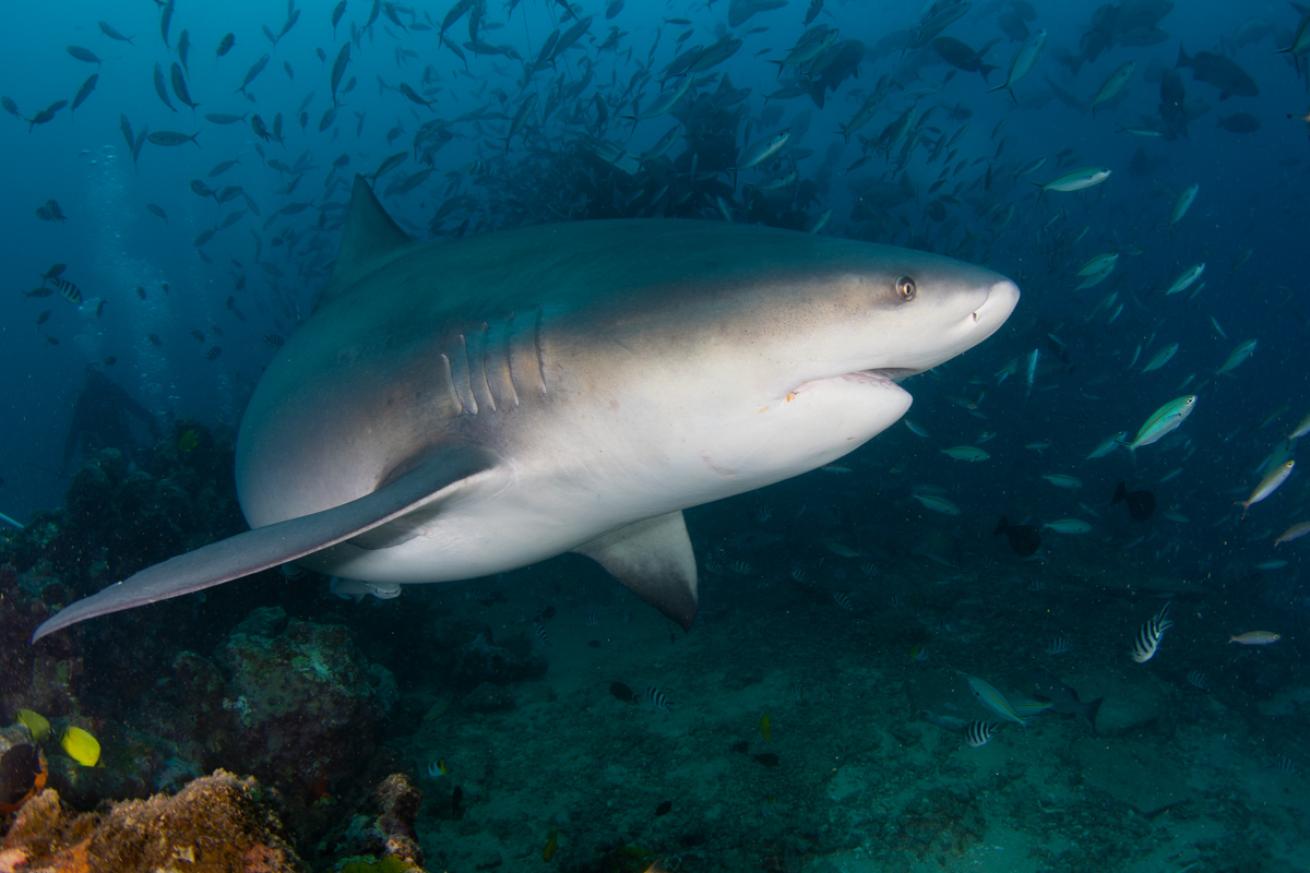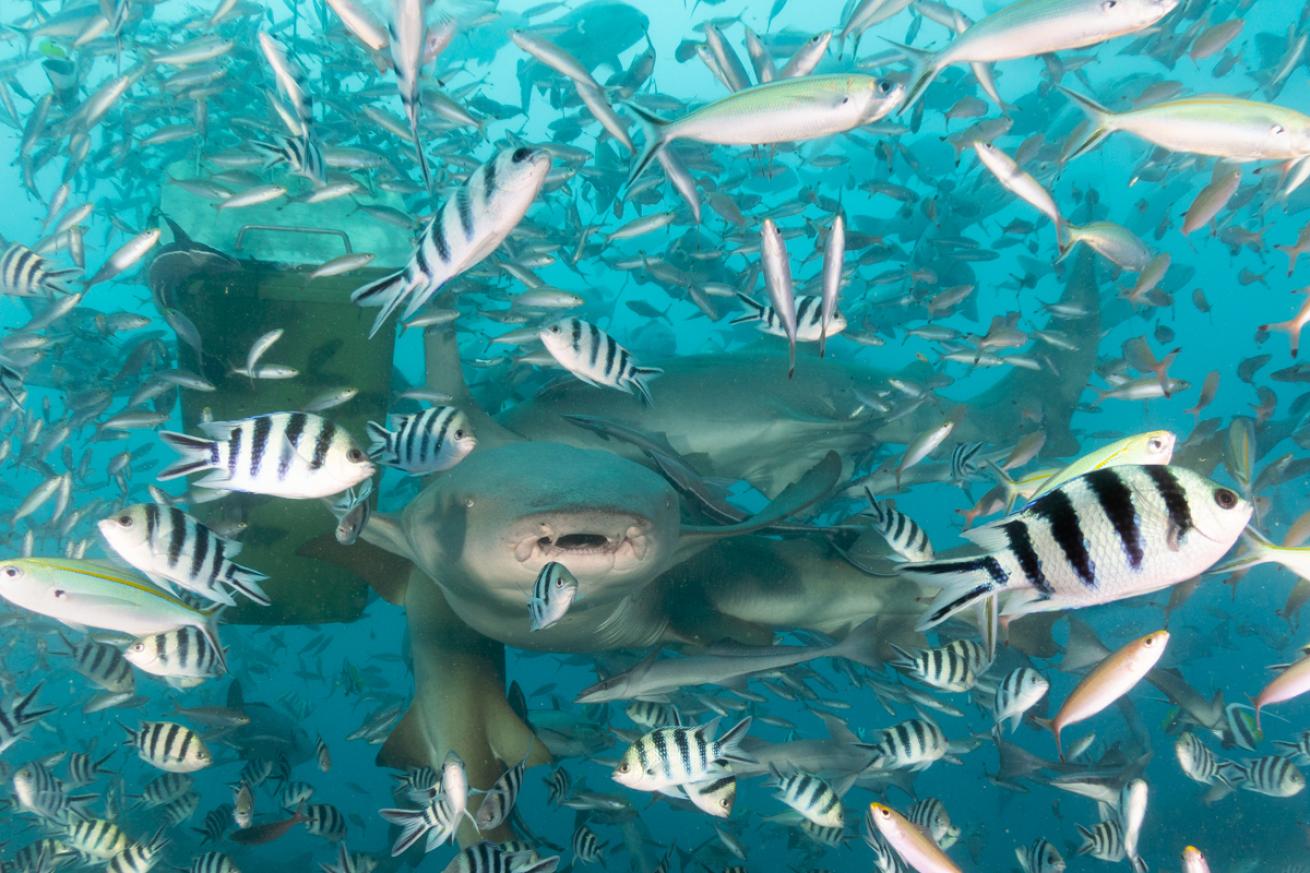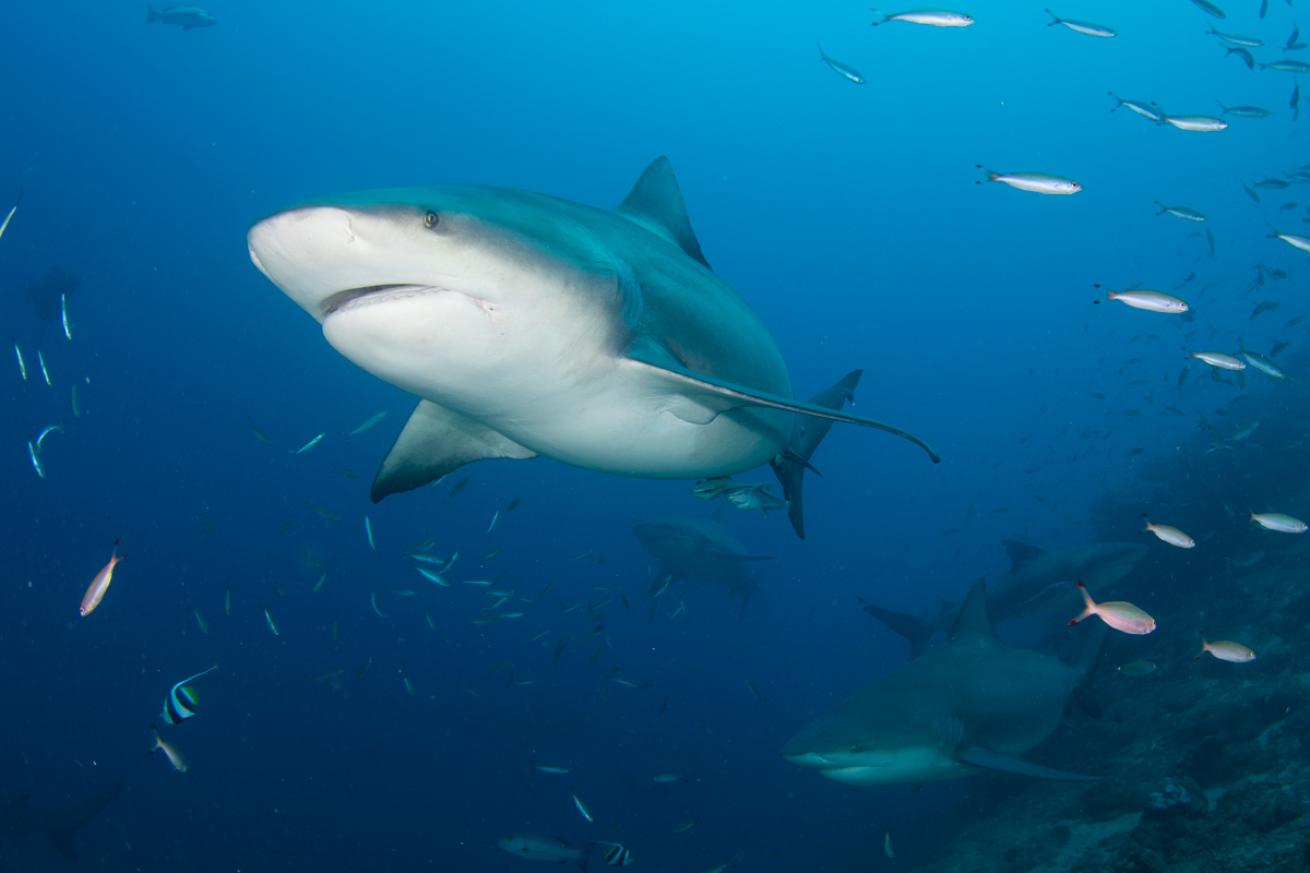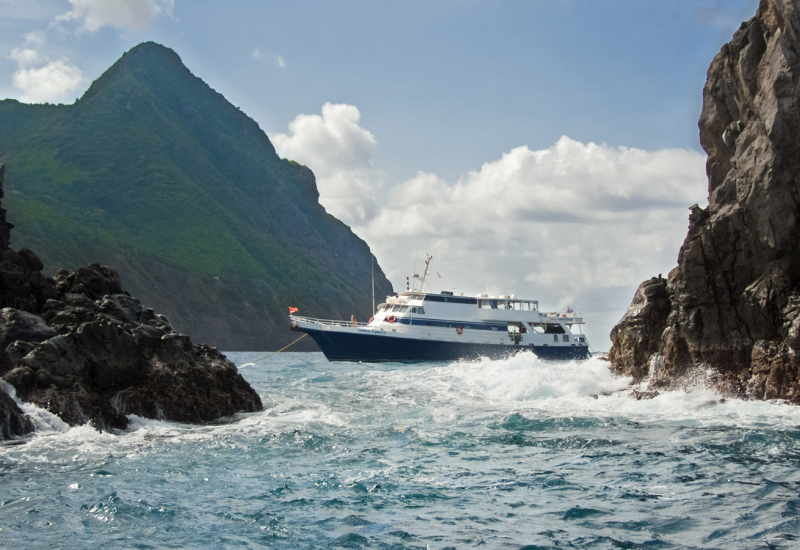How Do You Save a Shark? Dive With It!

Kim Randall/@DesignedforScubaA bull shark swims through The Bistro dive site.
Fifteen divers kneel behind a low wall of coral at The Bistro dive site in Pacific Harbour, Fiji. Above, a bull shark swims in lazy circles—an early arrival to the feast.
Sharks have traversed the Beqa Lagoon just off the main island of Viti Levu for as long as anyone can remember. With more than 200 individual sharks identified, and counting, it’s the largest aggregation of bull sharks in the world.
In other countries, these apex predators are fished for their fins and oil, or caught in commercial fishing nets as bycatch. But here, dive shops, Fijian divemasters and government officials have been working to ensure that everyone knows the resident sharks are worth protecting.
“Knowledge is key for a country like Fiji,” says Manoa Lauvili, divemaster and marine biologist with Aqua-Trek, one of the dive companies working to preserve sharks and marine life in the area. In fact, that knowledge is a global need. Researchers believe that worldwide shark and ray populations have declined more than 70 percent since 1970, largely because of overfishing. Sanctuaries like Fiji’s Shark Reef Marine Reserve help combat the grisly trend.
At The Bistro, the dive crew lowers a trash bin brimming with chum and sharks come speeding from every direction—literally appearing out of the blue. There are reef sharks and perhaps a dozen bulls, all enveloped by a cloud of fish looking for their own little piece of the action. The reserve is home to eight shark species, including bull bull, whitetip, blacktip and grey reef, tawny nurse, sicklefin lemon, silvertips and tiger sharks, as well as more than 450 species of fish.
After the initial feeding frenzy, several sharks cruise within arms’ reach of the divers, who are busy gawking and snapping once-in-a-lifetime photos. Sharks don’t have great eyesight, they rely on smell and a unique electrosensory system for hunting, so the divemasters—Las, Fabil, Api, Mase, Simi, Misi, Manoa and Leps—use shakers or make a back-of-the-throat “ngh, ngh” sound to shoo them from the wall when they get too close. As a failsafe, they carry aluminum poles with looped ends to give the sharks a gentle nudge in the other direction. Once the sharks have cleared the area, the divers descend to the coral-littered bottom to find freshly shed shark teeth to take home as souvenirs.
Fiji’s Shark Reef Marine Reserve supports local economies while helping preserve the planet’s biodiversity. It’s estimated that shark diving contributes more than $42 million to the Fijian economy every year. Divers at the lagoon pay a small park levy to the villages of Wainiyabia and Galoa, the reefs’ traditional owners. In return, the villagers agree not to fish within the marine protected area. "Reef wardens" patrol the reef and drive away illegal fishermen, although, occasionally, long-line fishermen have still been known to sneak into the area at night.

Kim Randall/@DesignedforScubaSharks flock to a bait box.
Sharks have long frequented the Beqa passage, but it took a bit of trial and error to develop a shark-diving system that would be safe for both guests and divemasters, says Lauvili, who has been involved with the lagoon’s shark dives for nearly a decade. At first, the companies tried hand-feeding tuna heads, but the sharks were reluctant, so they moved to the bait box. The reef sharks were the first to visit the feeding site; the bulls came soon after. The reserve was officially established in 2004.
Provisioning is not without controversy. Many critics fear long-term feeding will alter sharks’ natural behavior patterns and make them dependent on divers. In the U.S., the National Oceanic and Atmospheric Administration recently proposed a rule that would prohibit tour operators from feeding fish, sharks or other marine species in the Florida Keys National Marine Sanctuary because of these concerns. For what it’s worth, at least one recent study of the Fiji reserve showed that current levels of provisioning there are unlikely to have long-term impacts on the bull sharks’ diet or behavior.
The reserve is Fiji’s first protected shark sanctuary, but the country has an extended cultural history of respecting the islands’ shark residents. Long ago, many believed the shark god Dakuwaqa guarded the reef entrance and protected fishermen and swimmers from harm. The reserve actively engages local communities in shark education and preservation. Several Aqua-Trek employees are from Wainiyabia, and the dive companies work with area high schools to involve students in beach cleanups and marine projects. A youth program helps train and employ local divemasters and fish wardens. This month, volunteers armed with VR headsets plan to give village elders a virtual glimpse of the shark feeding area, Lauvili said. He explained that most of the elders have never experienced the astonishing underwater landscape just outside their village. “They only know fishing from the boat.”

Kim Randall/@DesignedforScubaFijian culture has long reveared sharks.
But even from the surface, it’s clear to see the reserve’s spillover effect of growing reef fish populations. The reserve’s benefits extend even beyond Fijian borders. The data collected at the reserve, including from a long-term satellite and acoustic bull shark tagging program, has served as a foundation for genetic and behavioral studies yielding new insights on the migrations, river habitats, biology and behavior of bull sharks in the region. Other projects collect traditional and local shark-related ecological knowledge. The website for Beqa Adventure Divers, another shark-dive operator, has links to some of the published research, including studies of the long-term effects of food provisioning and other interesting questions like the average retention time of internal acoustic transmitters and whether or not sharks can be said to have friends.
Back on the boat, divers warm in the tropical sun as Skipper Ratu Qio steers the boat back to Viti Levu.
“Sharks have a purpose,” says Lauvili. “They’re very, very important. It’s their habitat, it’s their environment. We don’t control the ocean. We just visit it, pay respect and come back out.”
A Climate Emergency
Fiji is on the cutting-edge of shark preservation, but this Pacific Island nation has another problem which they cannot solve locally: Climate change.
Even though Fiji is responsible for negligible carbon emissions, it is among the top 15 countries with the highest disaster risk due to changing climate.
About 75% of the country’s population lives along the coastline, making villages vulnerable to coastal erosion, saltwater intrusion and rising seas, according to an article published last month in The Fiji Times by Vinay Singh, Director of Policy for Fiji’s Ministry of Waterways, and Commonwealth Climate Finance Adviser Katherine Cooke.
Already, coastal villages are being abandoned as the ocean encroaches. As The Guardian recently reported, six Fijian villages have already been relocated due to rising sea levels, with 42 additional villages earmarked for potential relocation within the next 10 years.
In 2021, the Fijian government declared a climate emergency and passed the Climate Change Act to support sustainable development objectives, including a target date for net-zero emissions. The government has been pleading with the globe's biggest polluters, including the U.S., to do more to combat climate change.
Are you ready to step up, help save the ocean, and #LiveUnfiltered at the same time? Sign up for a PADI Open Water Diver course now.











